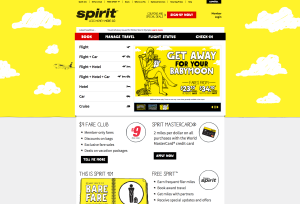Month: February 2016
Website Basics Checklist
We’re capping off February’s month-long focus on websites with a checklist to guide you through the web development process.
Following these guidelines will ensure that your new website is built on a solid foundation. Or, use it to assess your current site and identify areas in need of improvement.
In addition to viewing the checklist below, you can download and save it for future reference.
SEO Basics for A&D Marketing
 Bad SEO. It happens more than you might think.
Bad SEO. It happens more than you might think.
You just refreshed your aerospace company website, and it looks and sounds great. But no one is seeing it because you forgot about optimizing your website for search engines.
Sure, lots of customers are finding you through referrals and at trade shows, but more and more are looking for you online. In fact, 94 percent of business buyers do at least some type of online research, so search engine optimization (SEO) matters.
No need to feel overwhelmed or intimidated. Search engines, like Google, Yahoo, or Bing, use multiple factors to determine exactly where your website will rank in search results. And don’t worry — SEO isn’t as complicated as you might think. Use this basic primer as a start and you’ll be well on your way to increased organic website traffic from prospective buyers.
What is SEO?
SEO is a combination of efforts to improve organic (unpaid) search rankings.
It includes on-page (factors on your website) and off-page (factors off your website) ranking factors.
Some on-page ranking factors include things like the quality of your content, the inclusion of relevant words and phrases, descriptive meta titles and tags, quick load time, and URLs that include meaningful and relevant keywords.
Off-page ranking factors include the quality of the websites that are linking back to your site, social media links and mentions, and the overall reputation of your website across the Internet.
How do I create good SEO?
There is no shortcut to creating good SEO, but it seems like everyone is looking for a front-of-the-line pass for top-ranking positions. Our best advice? Just produce consistent, relevant and timely content to establish your business as a credible and trustworthy industry expert.
Where should I start?
SEO Must-Haves
- Quick site speed: Make sure that your load time is acceptable. There are plenty of online tools to help you determine your load time, even if you’re not a developer. Check out Moz’s toolbox here.
- Internal linking (linking from pages on your website to other pages on your website)
- Meta data (title tags, descriptions, and image alt tags)
- Mobile friendly
- Social media: Are you making posts on multiple social media platforms that will drive traffic back to your website? Pro tip: Don’t forget about Google owned Google+
- Links on other websites to yours (directories, blogs, etc.): Think about places beyond your website. Are there industry directories or blogs that you can be a part of?
SEO Must-Avoids
- Duplicate content: This might seem like an easy way to have more content or keywords on your website, but Google warns against it. Don’t fall into this trap.
- Hidden text: This is also a “black hat” tactic as Google would call it. It’s a shortcut that could very quickly have you blacklisted by Google
- Keyword stuffing: First and foremost, you need to make sure that your website is readable and user friendly. An overuse of keywords will make your website hard to understand for users
- Link buying: Guest blogging might be a great way to get quality links back to your website, but do not get in the habit of exchanging links and do not ever pay to have a link placed on a website
Want to learn more? Here are three resources for in-depth information:
Get Inspired: 5 Good A&D Websites
 We’ve written extensively about the importance of having a robust, user-friendly website. The website is where your buyers will start the process of connecting with you, it’s the front door to your business, and it’s the hub of your entire marketing program. No pressure, but you have to get it right — and it all starts with your homepage.
We’ve written extensively about the importance of having a robust, user-friendly website. The website is where your buyers will start the process of connecting with you, it’s the front door to your business, and it’s the hub of your entire marketing program. No pressure, but you have to get it right — and it all starts with your homepage.
Hubspot put together a great article about what makes a good website and explains that the most brilliant homepages have all or most of these 7 qualities:
- Clearly answers “Who I am,” “What I do,” and/or “What you (the visitor) can do here”
- Resonates with the target audience
- Features a compelling value proposition
- Offers great navigation, usability, and mobility
- Includes calls-to-action (CTAs) to guide visitors to the next logical step
- Is always changing to reflect the needs, problems, and questions of its visitors
- Has a great overall look and feel
With these guidelines in mind, we thought it would be helpful to provide examples of aviation, aerospace and defense companies that are checking all the boxes for making a great first impression online. It’s not too surprising that there are only a couple of true B2B businesses represented in our top picks. The truth is that there is lots of room for improvement in this segment, with B2C enterprises generally being one very big step ahead.
Use these sites for ideas, inspiration and to gain a better understanding of what works. Here are BDN’s picks for the best of aerospace industry websites.
If you’re looking for inspiration, look no further than Spirit. Spirit’s marketing is top-notch across-the-board, so we expected nothing less online. Their clear and simple value proposition is front and center, and the site oozes personality and charm. The homepage provides clear tools that describe how Spirit works, and presents its pricing in a clear, easy-to-understand way. Unique colors, bold graphics, animation, and compelling calls-to-action pull everything together.
This site isn’t perfect or sexy, and it’s not breaking any new ground. But it’s doing a lot of things right, with a simple and direct value proposition, clear calls to action on the home page (Shop Fixed Wing, Shop Rotor Wing, Shop Engines/APU) and easy-to-find information about the aircraft and manufacturers Able supports. Need a part? Just use the simple search function. It’s a lot of information that could easily be overwhelming, but it’s not.
Clean, clever and classy, this site is completely in keeping with the Embraer brand and buyer. While we’d like to see gated content and more prominent calls to action, the aircraft comparison and range circle features are engaging and helpful, and the overall design is a breath of fresh air.
Like Spirit, the guys and gals at Gogo are masters of marketing, and their website reflects that understanding and expertise. Sure, it’s predictably aviation blue, but its uncluttered design and punchy messaging are atypical. Four oversized calls to action dominate the home page, and we love the way the navigation is built around buyers, and not the company or its products.
Quality imagery? Yes, please. Minimal but evocative copy? Love it. Stunning visuals take center stage here and underscore the importance of investing in the best possible photography. The eye candy invites the visitor to spend time exploring before taking a deeper dive for details about features, benefits and specifications. It’s an effective approach that’s unusual for our industry. The call to action is straightforward and easy to find – “Buy A5.” This website is proof that less is more, and we wish more industry sites would follow suit.
Bonus picks
At the risk of self-promoting, we think there’s a lot to learn from these BDN-developed sites, too:
Though there is a clear call to action, this website really isn’t about selling in the traditional sense. Instead it’s about storytelling, building credibility and generating excitement. BDN accomplished these goals with a fluid design where each page is one chapter in a larger story. Notably the site provides access to a media section. Hosting the latest news helps build credibility, and showcasing the impressive list of outlets that have featured the company enhances the brand. A regularly updated blog is part of the overall marketing strategy while also improving SEO and actively generating leads.
This site is all about giving buyers tools and information they need to drive preference and decisions while also serving as an important tool and force multiplier for the sales team. There’s a ton of downloadable content, including case studies, infographics and white papers, all with frequent calls to action. The straightforward navigation and modern design are refreshing, too. The strategically placed gated content and forms deliver hot leads to sales while providing valuable insight into the audience’s areas of interest. A portal for sales reps hosts an array of easily accessible tools.
It’s important that we practice what we preach, so BDN recently overhauled our own website to function with a clear goal of sales enablement. To learn more about how this lead generation effort is working for BDN, request a copy of our case study here
The 9 Things You Must Consider Before Redesigning Your Website
 We speak frequently with aviation, aerospace and defense marketers or business owners who call us to inquire about our web development capabilities. We love talking with them and learning about their challenges. Lately, we notice more people coming to us with concerns about the visual aspect of their sites, with many expressing a desire to update the site’s aesthetic appeal.
We speak frequently with aviation, aerospace and defense marketers or business owners who call us to inquire about our web development capabilities. We love talking with them and learning about their challenges. Lately, we notice more people coming to us with concerns about the visual aspect of their sites, with many expressing a desire to update the site’s aesthetic appeal.
The Ugly Truth
We’re all for great-looking websites — they help us keep the lights on and they are essential to a healthy brand. But, frankly, a cosmetic update alone is like putting lipstick on a pig. It doesn’t change the fact that the website is fundamentally bad and not functioning as it should. It just makes the still-bad website look better.
It’s good to pay attention to your website. It’s an extension of your sales team and is arguably the most important part of any B2B marketing program, so it has to be right.
Back to Basics
When considering a website refresh, be sure you are focusing your time and energy on the right things. Here’s a list of 9 basics that are more important than visual appeal.
- Analytics: Do you have Google Analytics installed on your website now? If not, stop reading this and do it now. It’s free, and analytics reports provide invaluable information and intelligence you need to understand prior to making any changes. You’ll learn everything from what people are searching for on your site to identifying best- and worst-performing pages. Learn more at Kissmetrics.
- Update Content: Do you regularly update the content on your site? Or has the content remained stagnant since it was launched? A lack of updated information results in poor search engine optimization (SEO), which makes it unlikely that prospective customers will find you. Updates ideally should happen at least two or three times a week. If you aren’t prepared to keep all content relevant and fresh (blogging is ideal), a redesign will be a waste of time and money. Learn more here.
- Calls to Action: What do you want visitors to do when they visit your website? Having an answer to this simple question, and addressing it with multiple clear and compelling calls to action (CTA), is vital to even the most basic website. Kissmetrics provides five foolproof CTA formulas here.
- Keywords/Metadata/Page Titles: These are the critical underpinnings of your website that are essential to good SEO. You absolutely cannot afford to overlook this aspect of web development. The people at Moz provide a detailed tutorial on all aspects of SEO. To learn about the magic of keywords, metadata and page titles, read Chapter 4.
- Mobile-friendly: This one’s a no-brainer. It doesn’t matter how great your website looks, if it’s not optimized for mobile viewing, your work will be wasted. Sites that are not mobile friendly are harder to find on Google.
- Clean: It only took a couple of minutes to find these errors (see visuals) on aviation, aerospace and defense websites. Errors and typos happen to the best of us, but they raise questions about professionalism and attention to detail, so try to avoid them at all costs. Apostrophes are especially problematic. Refer to your AP Stylebook for details.
- Clear: This is an aerospace company with a fairly well known brand name. Can you tell what they do within just a few seconds of visiting their home page? “One Name. Many Solutions.” Hmm, that does not tell us much at all. Please don’t fall into this trap. Whatever you do, be sure to clearly state who you are, what you do and why visitors should care. Make it prominent. Make it clear. And make it matter. People will stay or leave your site based on this information.
- Usable: Take a step back and try to look at your website as a first-time visitor. Does it load quickly? Do all the links work? Is the presentation of information simple and focused or crowded and confusing? A usable website is one that intuitively and effortlessly guides visitors so they know how to find what they need. Able Aerospace has a good, meat and potatoes website clearly designed to satisfy the needs of its visitors. It’s not slick or sexy, but it gets the job done with a straightforward value proposition, easy navigation and frequent calls to action.
- Contact: Some people don’t want contact information posted on their website, because they don’t want to be bothered by phone calls. If this sounds like you, don’t bother having a website. Otherwise, make sure your web site includes complete, up-to-date, easy-to-find contact information. Thales Group is one example of a company that does not make it easy. We were unable to find any phone numbers, but did find a “contact us” page that required we select a topic, then a business domain, a geographical area, product type and activity domain, and then fill out a form with seven required fields. We wonder how many people use the system.
- Lastly, design: Once you can commit to all of the above you are ready for design. Aim for clean, modern and distinct — like this. It will set you apart from a sea of aviation, aerospace and defense websites that all look and sound alike. There are lots and lots of online resources for best practices in B2B web design. Or, be inspired by BDN’s own recently updated website.
Want more? We guarantee you’ll find this Content Marketing Institute article, “Why 55% of Potential B2B Buyers Might Not Trust Your Website Content,” to be especially helpful.

